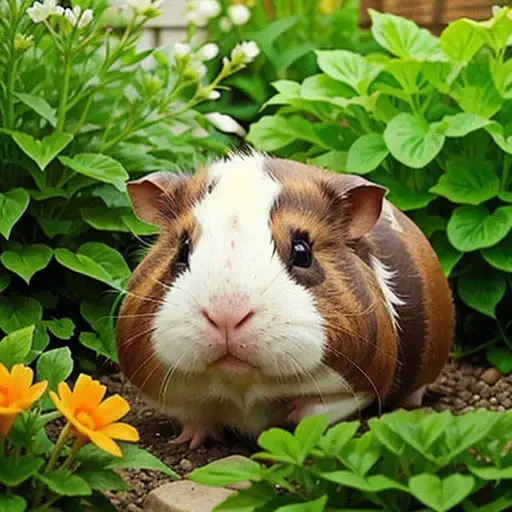How Big Do Guinea Pigs Get: A Comprehensive Size Guide
When considering the size of guinea pigs, it’s intriguing how such tiny creatures can exhibit a wide range of dimensions. Understanding the factors that influence their growth can provide valuable insights into their overall well-being.
From gender disparities to differences among breeds, each aspect plays a crucial role in determining the size of these adorable pets. However, there’s one crucial element that often goes unnoticed, and it might just surprise you.
Stay tuned to discover this hidden factor that can significantly impact the size of guinea pigs and how it shapes our understanding of these delightful companions.
Factors Influencing Guinea Pig Size
When considering the size of a guinea pig, it’s essential to understand the various factors that can influence their growth and overall dimensions. Gender plays a crucial role, with male guinea pigs generally larger than females. Additionally, different breeds of guinea pigs exhibit varying sizes, with the Rex breed being the largest, and the Texel and American breeds being the smallest. Genetics, diet, health, and birth order also play significant roles in determining the size of a guinea pig.
Male guinea pigs typically weigh between 2 to 3.5 pounds when fully grown, while females generally weigh around 1.5 to 2.5 pounds. Responsible pet ownership practices, such as providing a balanced diet and regular veterinary check-ups, are essential for ensuring healthy growth and size in guinea pigs. By understanding these factors and implementing healthy growth practices, guinea pig owners can help their pets reach their full size potential and ensure their well-being.
Growth Stages of Guinea Pigs
Throughout their development, guinea pigs undergo distinct growth stages that mark significant changes in their size and physical development.
- Newborn guinea pigs typically measure 8-10 cm (3-4 inches) in length.
- Guinea pigs double in size to 15-20 cm (6-8 inches) by 8 weeks old.
- Growth slows down after 8 weeks, with guinea pigs reaching 20-25 cm (8-10 inches) by 16 weeks.
- Rapid growth occurs up to 14 months old, with full growth at 20-30 cm (8-12 inches).
- Guinea pigs stop growing at around 14 months old.
Understanding these growth stages is essential for guinea pig owners to provide appropriate care and nutrition as their pets develop. Monitoring their size at different milestones can help ensure they’re growing healthily.
Gender Variation in Guinea Pig Size

As we explore the topic of gender variation in guinea pig size, it becomes evident that male guinea pigs generally outweigh their female counterparts, with males typically ranging from 2.2 lb to 3.5 lb. Female guinea pigs, on the other hand, weigh around 2 lb to 2.5 lb. In terms of length, females usually measure between 8 to 10 inches, while males can reach up to 12 inches. These size differences between male and female guinea pigs start becoming noticeable as early as 3 weeks old and are considered a natural variation in guinea pig development.
Understanding the gender variation in size is essential for identifying and caring for guinea pigs correctly. By recognizing the differences between male and female sizes, caretakers can provide appropriate housing, diet, and medical care tailored to each gender’s specific needs. This knowledge contributes to ensuring the overall health and well-being of these adorable pets.
Breed Differences in Guinea Pig Size
Exploring the realm of guinea pig breeds reveals a diverse range of sizes among different varieties, each showcasing unique physical characteristics and dimensions. When it comes to breed differences in guinea pig size, there’s a noticeable variation that enthusiasts find intriguing.
Here are some key points to consider:
- The largest guinea pig breed, the Rex, can reach up to 17 inches in length.
- Smaller breeds like the American and Texel typically measure around 8-10 inches.
- Abyssinian guinea pigs weigh between 2-3 pounds, while Texel and American breeds are around 1.5-2.5 pounds.
- Cuy guinea pigs can weigh between 4-8 pounds, showcasing significant size variation among breeds.
- Different guinea pig breeds have distinct size ranges, with Rex, Abyssinian, American, and Texel breeds exhibiting varying sizes.
Understanding these breed differences in size is crucial for guinea pig owners to provide appropriate care tailored to the specific needs of their furry companions.
Monitoring and Measuring Guinea Pig Size

When observing and evaluating the size of guinea pigs, it’s essential to accurately measure their length from nose to rear for a comprehensive size assessment. Guinea pigs typically grow to 8-10 inches in length as adults.
To monitor guinea pig growth effectively, tracking weight weekly is crucial for their overall health. Newborn guinea pigs measure around 3-4 inches long and double in size by 8 weeks.
To measure the length of a guinea pig correctly, utilize a ruler or tape measure on a flat surface for precision. This method ensures an accurate size assessment and helps in tracking any size variation that may occur.
Whether dealing with newborn or adult guinea pigs, proper measurement techniques are key to understanding their growth and overall well-being. By consistently measuring and tracking their size, you can ensure that your guinea pigs are developing as expected and maintain their health at optimal levels.
Conclusion
In conclusion, understanding the factors that influence the size of guinea pigs, including gender, breed, and growth stages, is essential for responsible pet ownership. By monitoring and measuring their size regularly, we can ensure they’re healthy and thriving.
Providing appropriate care and attention to their specific needs will contribute to their overall well-being and happiness. Remember, a little extra love and care go a long way in helping these adorable pets reach their full potential size.







